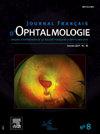Genotyping methods for Fuchs corneal endothelial dystrophy
IF 1.2
4区 医学
Q3 OPHTHALMOLOGY
引用次数: 0
Abstract
Fuchs endothelial corneal dystrophy (FECD) is a genetic degenerative disease characterized by the progressive degradation of the corneal endothelium, often leading to vision loss. It is the leading cause of corneal transplantation in the Western world. FECD is more common in Europe and the United States, particularly among women. FECD manifests in two forms: an early-onset, rare form linked to mutations in the COL8A2 gene, and a late-onset, more common form associated with the expansion of the CTG18.1 triplet in the TCF4 gene. This expansion is present in about 70% of Caucasian patients with the late-onset form and can cause cellular dysfunctions. In this article, we present a review of the techniques used to genotype variants of genes associated with FECD. Six genotyping methods have been identified. Each method has advantages and disadvantages in terms of cost, throughput, sensitivity, and specificity: STR PCR, TP PCR, Southern Blot, Sanger Sequencing, short-read NGS, and long-read NGS. FECD presents complex genetic challenges. A combined approach using various genotyping techniques is necessary for a comprehensive characterization. Two strategies seem promising for diagnosis and research in this field: (1) the combination of STR PCR and TP PCR followed by short-read or long-read NGS; and (2) long-read NGS alone. These approaches allow for more precise characterization of genetic variants, thus facilitating a better understanding of the underlying mechanisms of FECD.
La dystrophie endothéliale cornéenne de Fuchs (FECD) est une maladie dégénérative génétique, caractérisée par la dégradation progressive de l’endothélium cornéen, souvent menant à une perte de vision. Elle est la principale cause de transplantation cornéenne en Occident. La FECD est plus fréquente en Europe et aux États-Unis, surtout chez les femmes. La FECD se manifeste sous deux formes : une forme précoce, rare, liée à des mutations dans le gène COL8A2, et une forme tardive, plus commune, associée à l’expansion du triplet CTG18.1 dans le gène TCF4. Cette expansion est présente chez environ 70 % des patients caucasiens atteints de la forme tardive et peut causer des dysfonctionnements cellulaires. Dans cet article, nous présentons une revue des techniques utilisées pour génotyper les variants des gènes associés à la FECD. Six méthodes de génotypage ont été identifiées. Chaque méthode présente des avantages et des inconvénients en termes de coût, de débit, de sensibilité et de spécificité: STR PCR, TP PCR, Southern Blot, Séquençage Sanger, NGS short-read, NGS long-read. La FECD présente des défis génétiques complexes. Une approche combinant diverses techniques de génotypage est nécessaire pour une caractérisation complète. Deux stratégies semblent être prometteuses pour le diagnostic et la recherche dans ce domaine : (1) la combinaison de la STR PCR et la TP PCR suivie du NGS short-read ou long-read ; ou (2) le NGS long-read. Ces approches permettent une caractérisation plus précise des variants génétiques, facilitant ainsi la compréhension des mécanismes sous-jacents de la FECD.
福氏角膜内皮营养不良症(Fuchs endothelial corneal dystrophy,FECD)是一种遗传性退行性疾病,其特点是角膜内皮逐渐退化,常常导致视力丧失。它是西方国家角膜移植的主要原因。角膜营养不良症在欧洲和美国较为常见,尤其是在女性中。FECD 有两种表现形式:一种是与 COL8A2 基因突变有关的早期发病的罕见形式,另一种是与 TCF4 基因中 CTG18.1 三连体扩增有关的晚期发病的更常见形式。约 70% 的晚发型白种人患者存在这种扩展,可导致细胞功能障碍。在本文中,我们对用于对与 FECD 相关的基因变异进行基因分型的技术进行了综述。目前已确定了六种基因分型方法。每种方法在成本、通量、灵敏度和特异性方面都各有优缺点:STR PCR、TP PCR、Southern Blot、Sanger 测序、短读数 NGS 和长读数 NGS。FECD 带来了复杂的遗传挑战。有必要使用各种基因分型技术进行综合分析。在这一领域的诊断和研究中,有两种策略似乎很有前途:(1) 结合使用 STR PCR 和 TP PCR,然后进行短读或长读 NGS;(2) 单独使用长读 NGS。福氏角膜内皮营养不良症(Fuchs' corneal endothelial dystrophy,FECD)是一种遗传性退行性疾病,其特点是角膜内皮逐渐退化,常常导致视力丧失。它是西方国家角膜移植的主要原因。CDEF 在欧洲和美国较为常见,尤其是女性。CDEF 有两种形式:一种是与 COL8A2 基因突变有关的罕见的早期形式,另一种是与 TCF4 基因中 CTG18.1 三连体扩增有关的更常见的晚期形式。大约 70% 的晚期白种人患者体内存在这种扩展,可导致细胞功能障碍。本文回顾了用于对 FECD 相关基因变异进行基因分型的技术。我们确定了六种基因分型方法。每种方法在成本、通量、灵敏度和特异性方面各有利弊:STR PCR、TP PCR、Southern Blot、Sanger 测序、NGS 短读数、NGS 长读数。FECD 带来了复杂的遗传挑战。需要结合各种基因分型技术来进行完整的特征描述。在该领域的诊断和研究中,有两种策略似乎很有前途:(1) 结合 STR PCR 和 TP PCR,然后进行短读或长读 NGS;或 (2) 长读 NGS。这些方法可以更精确地描述基因变异的特征,从而促进对 FECD 潜在机制的了解。
本文章由计算机程序翻译,如有差异,请以英文原文为准。
求助全文
约1分钟内获得全文
求助全文
来源期刊
CiteScore
1.10
自引率
8.30%
发文量
317
审稿时长
49 days
期刊介绍:
The Journal français d''ophtalmologie, official publication of the French Society of Ophthalmology, serves the French Speaking Community by publishing excellent research articles, communications of the French Society of Ophthalmology, in-depth reviews, position papers, letters received by the editor and a rich image bank in each issue. The scientific quality is guaranteed through unbiased peer-review, and the journal is member of the Committee of Publication Ethics (COPE). The editors strongly discourage editorial misconduct and in particular if duplicative text from published sources is identified without proper citation, the submission will not be considered for peer review and returned to the authors or immediately rejected.

 求助内容:
求助内容: 应助结果提醒方式:
应助结果提醒方式:


